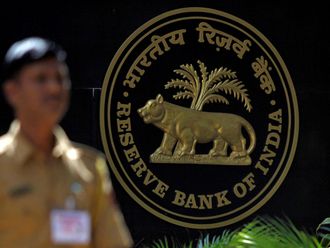_resources1_16a3106f48a_medium.jpg)
Prayagraj: Followers from across the world are gathering in India for the festival of Kumbh Mela, a mix of spirituality, politics and tourism that begins on Tuesday, garnering extra attention ahead of a general election this year.
During the eight-week festival, at Prayagraj in the northern state of Uttar Pradesh, authorities expect up to 150 million people, including a million foreign visitors, to bathe at the confluence of the Ganges, the Yamuna, and a mythical third river, the Saraswati.
Devout Hindus believe that bathing in the waters of the Ganges cleanses people of sins and bathing at the time of the Kumbh Mela, or the “festival of the pot”, brings salvation from the cycle of life and death.
Kumbh Mela has been inscribed on the list of the “Intangible Cultural Heritage of Humanity” by Unesco and representatives from 192 nations have endorsed their participation.
Sitting in his akhara (camp) an elderly seer, Girijanand, who has attended several Kumbh Melas, says this year’s event will be a magnum opus.
“The magnitude of the event is out of this world, this time. The amount of work and effort put into organising it is worthy of a praise,” he says, adding that it can be a huge learning experience for the youth to understand culture and tradition.
_resources1_16a3106f49a_original-ratio.jpg)
His words echo the UP government’s spending spree as the budget for the festival has gone up from Rs13 billion (Dh673 million) to Rs42 billion. Even the size of the fair ground has increased from 20 kilometres to 32km.
That apart, amenities like hospitals, air and river ambulances will cater to the health needs of saints and pilgrims. Among the many firsts, this Kumbh will have an eco-friendly deepwater barricading of plastic instead of wood.
Known as the festival of the sacred pitcher, the 48-day event starting January 15 will showcase science of astronomy, astrology, spirituality and ritualistic traditions, as devotees bathe at the Triveni Sangam — the confluence of the Ganga, the Yamuna, and the mystical Saraswati to cleanse their wrongdoings and gain “moksha” or freedom from the mortal world.
Sanjay Rai, Deputy Director, Information & Public Relations Department, Uttar Pradesh, says, “The enthusiasm over Kumbh Mela is palpable. The ‘Paint My City’ concept has turned Prayagraj into an outdoor art gallery. Not only official buildings, but also homes and trees lining the streets have been painted in vivid colours. Kumbh is the biggest temporary city of the world because of the sheer number of people living in it and the massive infrastructure.
“Harvard University considers it to be a case study for a concept that they refer to as a pop-up mega city. Kumbh provides a forum for both individual and collective expressions of faith as both saints and pilgrims converge from all parts of India and abroad,” he says.
150 million
devotees are expected to visit during the eight-week festival
The fair is marked by the construction of a massive tented township, including cottages, huts, platforms, police stations and administrative and security measures.
The entire area has been divided into 20 sectors, with each having a different layout. These will comprise akharas, convention halls, exhibitions, yoga centres, food courts, amusement parks, merchandising kiosks, laser shows, a tent colony and tent city.
While the Kumbh in 2013 had only 34,000 toilets, this year, 125,000 toilets and 20,000 dustbins have been set up, which will be tended to by over 15,000 sanitation workers. Sunil Kumar, in-charge of sanitation, explains, “To keep the river clean, the National Green Tribunal has banned commercial activity in certain areas. The state government also closed all tanneries in adjoining Kanpur and Unnao areas.”
Close to the tent city venue; giant arched gateways have been constructed, giving an impression of a movie set where a historical film is being shot. The man in charge is art director Anant Baburao Shinde, a Bollywood veteran of 40 years. “We are creating a design of the Samundra Manthan (churning of the ocean) and the 14 ratnas (jewels) that emerged from it,” he briefs.
_resources1_16a3106f49a_original-ratio.jpg)
Shinde, who has worked with Bollywood icons including Dilip Kumar and Gulzar, has also designed paintings and figurines on various themes including: Beti Bachao (save the girl child) and Save Trees.
— with inputs from Reuters
The akharas (camps) steal the show at the Kumbh Mela.
Mahant Prem Giri of Niranjani Akhara says, “I have come from Haridwar and never witnessed such enthusiasm for Kumbh before. The aim of the Kumbh is to spread the fragrance of Indian spiritualism and ethos across the world. This seems to be happening this time round.”
At another akhara, Naga Babas smeared in ashes from head to toe and wearing hair in long dreadlocks sat with other saints. (An akhara is a wrestling arena. It is an organisation of the different sects of saints and yogis, who have renounced the world. The history of akharas dates back to 2500BC, when these were established with an aim to strengthen the Hindu religion and unite those practicing different rituals, customs and beliefs).
192 nations'
representatives will take part in world’s largest religious festival
For the first time, the festival will see participation from the transgender community. Known as ‘Kinnar Akhara’, the priests are calling it a step forward towards inclusiveness of transgenders in the society.
The 13 akharas participating in Kumbh are divided into different camps according to the concept of the deity they worship. The followers are worshippers of Shiva, Vishnu and Brahma. Kumbh is especially renowned for the presence of an extraordinary array of religious ascetics — sadhus and mahants, who gather here from remote hideaways in mountains, caves and forests.
On specific auspicious dates, a colourful and magnificent procession of saints sitting on elephants and horse drawn chariots will be witnessed by millions of visitors. Belonging to various akharas, the saints will take a dip in the holy River Ganga first and only then the pilgrims will be allowed to take bath in the river. Of these akharas, the Mahanirvani is the first to take the ‘Shahi Snan’ (royal bath) that marks the beginning of Kumbh. It is followed by the Niranjani, Juna and others and Nirmal Akhara the last.
The event is held every six years and the fair has traditionally been called the ‘Ardh Kumbh’ (half event). However, while launching the Kumbh logo last year, Uttar Pradesh Chief Minister Yogi Adityanath announced the renaming of the ‘Ardh Kumbh’ as ‘Kumbh 2019’ since nothing is incomplete in Hindu philosophy, therefore, the word ‘ardh’ (half) does not fit, he said while quoting the Vedas.
Nonchalant whether it is ardh (half) or purna (full) Kumbh, cab driver Satish Kumar questions, “What difference does it make?”
“The occasion has changed the face of the city with new air-road-rail connectivity and other infrastructure facilities, including flyovers, over-bridges and widening of roads constructed in record time. The fact that Prayagraj is part of Smart City project has added to the developmental work,” he adds.
_resources1_16a3106f49b_original-ratio.jpg)
On Tuesday, millions of pilgrims, led by naked, ash-smeared ascetics, some of whom live in caves, will plunge themselves into the cold waters during the first Shahi Snan, or Royal Bath, that begins at around 4am (2230 GMT).
With less than 24 hours until the festival starts, the last of the arriving ascetics paraded towards temporary ashrams, or monasteries, built of corrugated iron and canvas, many bedecked with fairy lights, on the east bank of the Ganges.
Pilgrims poured in to the site, which is closed to traffic around bathing days, carrying bundles on their heads, while vendors peddled balloons and candyfloss, as security men stood guard, with priests and police seated side-by-side.
Authorities have set up temporary bridges, 600 mass kitchens and more than 100,000 portable toilets in a pop-up city at the confluence of the rivers, which is known as the sangam.
Those with cash can stay at luxury campsites on the river banks that offer ayurvedic spas and yoga, and cost up to Rs32,000 (Dh1,657 or $455) a night.
Most pilgrims make do with more modest lodgings, sleeping in big communal tents or out in the open.
On Monday, a small fire broke out at one of the camps, though there was no report of any casualty, according to ANI. Authorities later warned pilgrims about open fires.
— with inputs from agencies












